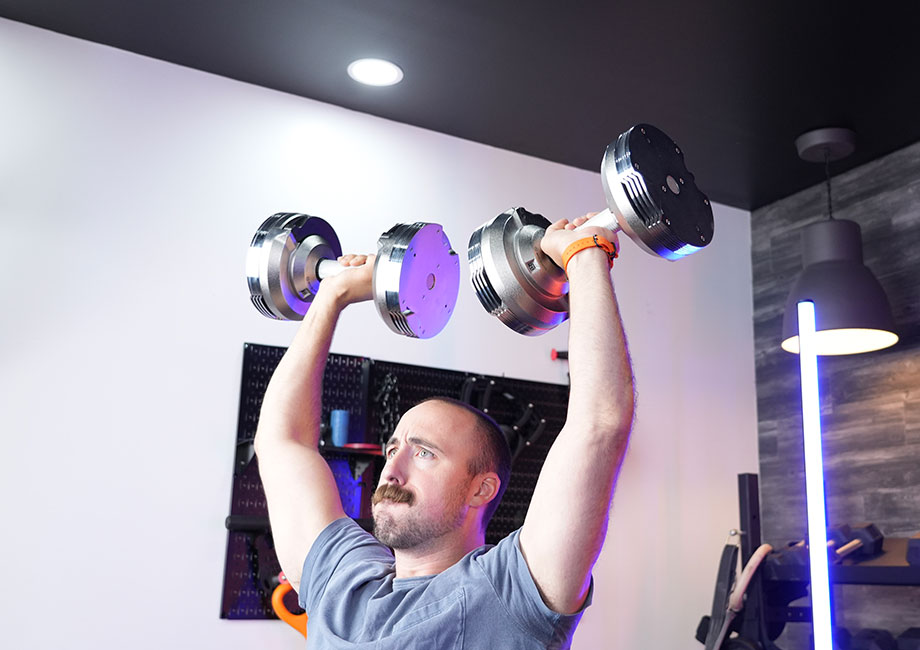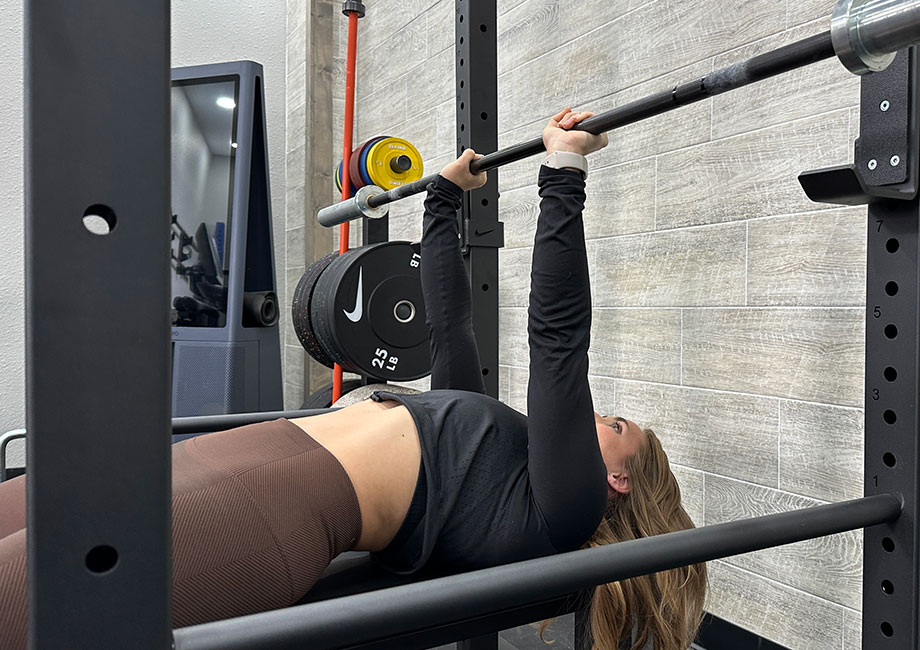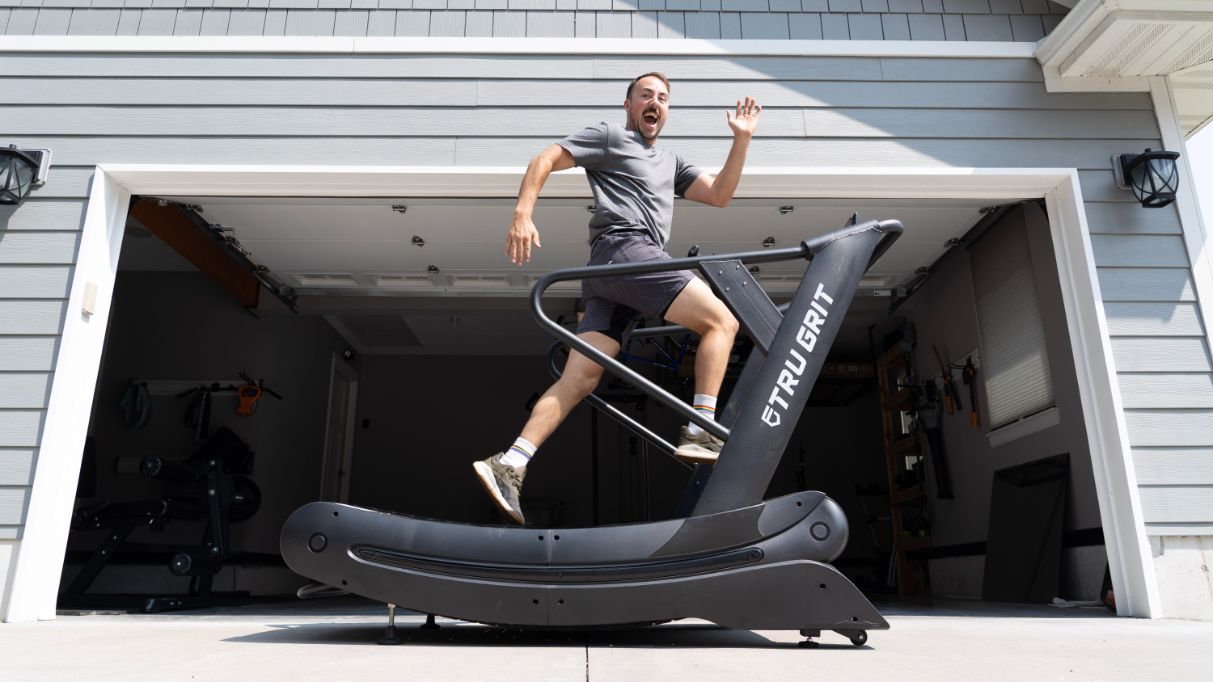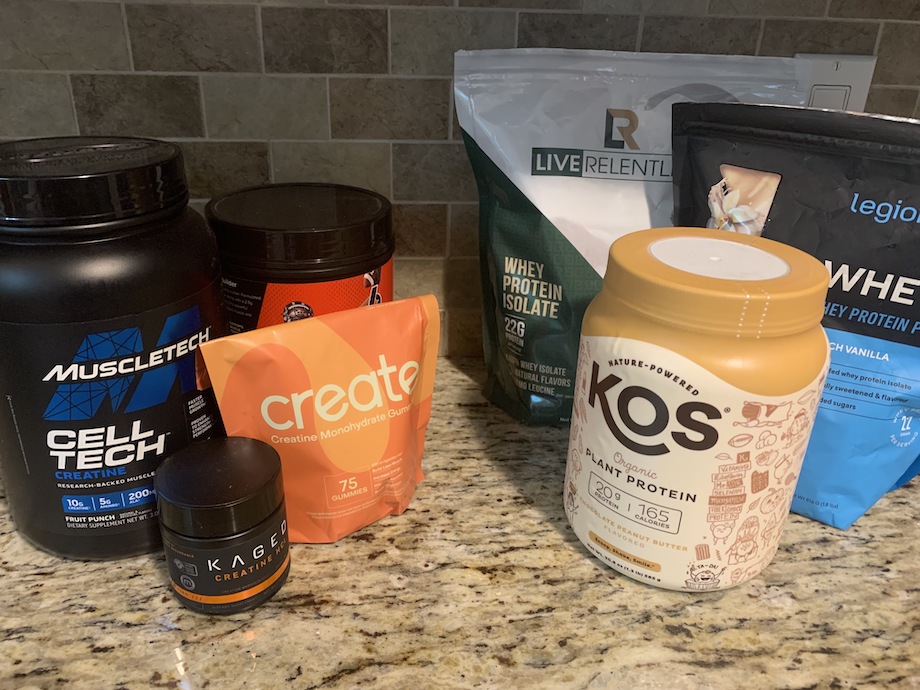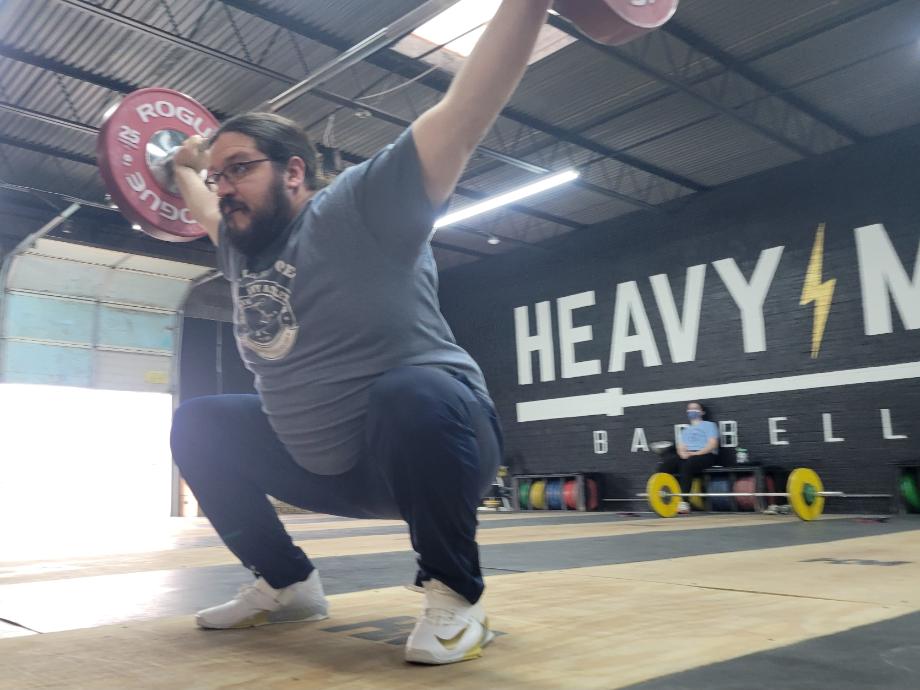Shoulder workouts with dumbbells are about more than just getting that classic chiseled appearance and boulder shoulder muscles. Strong shoulders are associated with increased shoulder stability, reducing your risk of shoulder injury1, as well as improved posture, enhanced sport performance, and an easier time performing everyday living tasks.
So, what movements help you reap those benefits? The tried-and-true overhead press works, and you can perform the exercise using free weights, machines, or resistance bands, making a versatile inclusion to your upper body workout routine.
Today, we’re focusing specifically on the dumbbell shoulder press. Amanda Capritto, CPT, CES, CNC, CF-L1, CSNC, shares step-by-step instructions for doing this unilateral variation of the standard shoulder press, including top trainer tips, mistakes to avoid, and much more!
RELATED: Best Shoulder Exercises
How to Do the Dumbbell Shoulder Press
- Stand with your feet shoulder-width apart.
- Hold two dumbbells at shoulder height with your elbows bent and palms facing away.
- Press the dumbbells overhead until your elbows are fully extended.
- Squeeze the contraction, then slowly return the weights to the starting position.
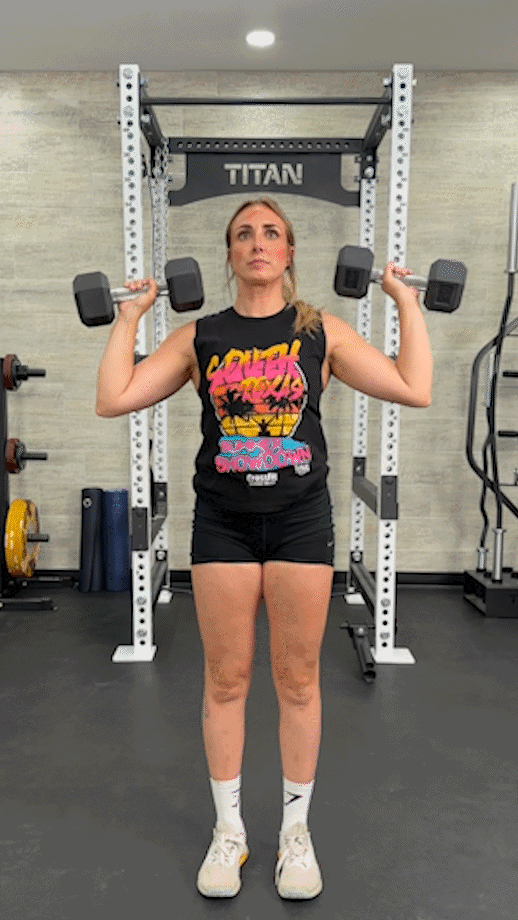
Trainer Tips for Form
If you want to get the most benefit from this fantastic shoulder exercise, you’re going to need to make sure you’re doing your reps with proper form. Amanda Capritto shares her top dumbbell shoulder press tips below.
Maintain Neutral Alignment
It’s crucial to maintain a neutral neck and back when performing the dumbbell overhead press.
“Neutral alignment2 ensures you’re able to generate power to move the dumbbells through the full range of motion,” says Amanda. “It also reduces your risk of injuries2 associated with back flexion or extension.”
Proper form for the dumbbell shoulder press has the following characteristics:
- Feet shoulder-width apart
- Knees slightly bent
- Hips, knees, and ankles vertically stacked
- Core braced
- Back straight
- Eyes facing forward
In the starting position, your shoulder blades will be retracted, and your elbows will be fully bent, but once you initiate and move through the movement pattern, your shoulders are going to open up as your elbows (nearly) fully extend.
Once you complete a rep, check in with your form again. You should still be maintaining all of the above characteristics at the top of the movement to ensure your neck and spine are protected.
Keep It Strict
There’s a name for recruiting your hips and lower body muscles for a dumbbell shoulder press. It’s called the push press exercise, and while popular in CrossFit and exceptional in its own right, it doesn’t function the same way as the strict shoulder press, nor does it provide the same benefits.
“The dumbbell shoulder press is all about maximizing our time under tension for the target muscle groups, namely the deltoids, triceps, trapezius, and pecs,” says Amanda. “So, you want to make sure you use these muscles to press the dumbbells overhead while your core and lower body muscles keep still.”
Of course, you’ll still want your core and lower body muscles contracted to provide maximum stability and protect you from injuries like pain, strains, and herniations, but these should be isometric contractions. All your movement derives from the upper body. Period.
Stabilize the Dumbbell Path
Dumbbells are known to provide superior muscle activation3 compared with barbells and selectorized machines. That’s because dumbbells move independently of each other. You’ll need to summon the strength of various surrounding stabilizer muscles to ensure the weights are steady throughout the range of motion.
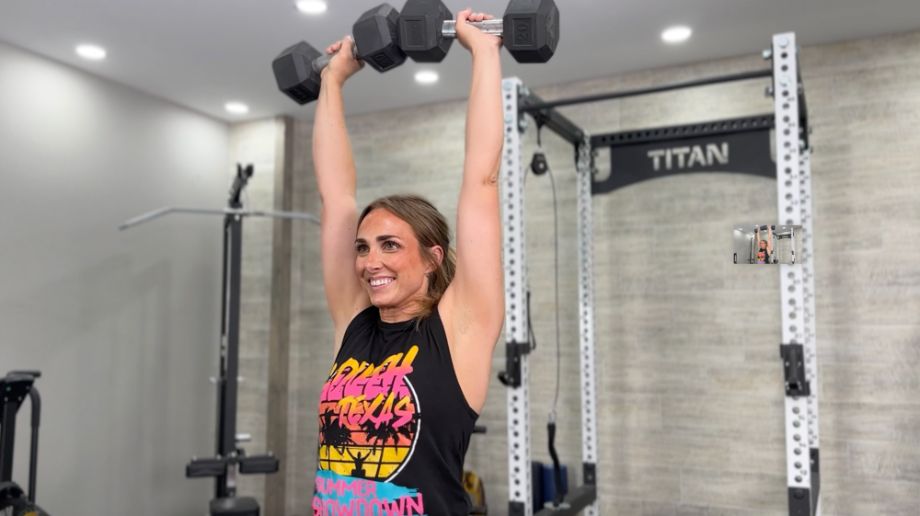
If you’re used to using barbells or machines to perform the overhead shoulder press, you may find out the hard way that your essentially-neglected stabilizer muscles aren’t up to the task and wind up with shaky dumbbells that move erratically throughout the movement. This is inefficient, but it can also increase your risk of injury if the dumbbell strays too far from the ideal path and improperly tweaks your muscles or joints.
“The ideal dumbbell path is completely straight,” says Amanda. “If you find your arms wobbling and the dumbbell becoming erratic, try switching to lighter weights. This should help you build muscle and keep things steady as you train your stabilizer muscles to lift heavier weights later.”
RELATED: Hypertrophy Workout
Common Dumbbell Shoulder Press Mistakes
Following our trainer tips should work well toward helping you maintain proper form during your sets of dumbbell shoulder presses. Here are a few common mistakes we hope to help you avoid as well.
Arching Your Back
Maintaining neutral alignment is crucial for ensuring you get the best power output from the target muscle groups, but it’s also important for ensuring your neck, spine, and other critical regions of the body are safe from undue stress and shear forces that could lead to or cause injuries.
Arching the back compromises your proper form, ruins that essential neutral alignment, and leaves you susceptible to pains, strains, injuries, or other adverse conditions.
To avoid this, check in with your form before beginning the movement, again at the top, and again before starting your next rep. Lift in front of a mirror if you’re not sure your form feels right, as seeing yourself in the mirror might make you more aware of any slight imperfections you can immediately address.
Working with a certified personal trainer or other qualified fitness professional never hurts either.
Pressing Your Hips Forward/Leaning Backward
The dumbbell shoulder press is called that because, well, you press the dumbbells overhead with your shoulders, but that’s just one of the exercise’s many names. It’s also called the military press because it’s commonly used during military training; and it’s also called the overhead press because the weights are pressed overhead.
Bringing your hips forward and leaning backward converts that overhead press into an awkward variant of the bench press, taking your spine out of alignment and straining your lower back in order to get some increased activation from the pec muscles.
“People will compensate with this improper body positioning as they become increasingly fatigued, but they also may assume this position if they’re trying to lift weights that are too heavy,” says Amanda. “Luckily, there are many ways to avoid this mistake.”
If you’re falling victim to this common mistake, try one of our quick fixes:
- Decrease the rep range: Losing proper form before you reach the end of your set means you’re possibly doing too many reps. Reducing the number of reps may help you maintain proper form throughout the full set.
- Decrease the dumbbell weight: Going too heavy may compromise your good form as well. Switch to some lighter dumbbells if that’s the reason your form is deteriorating.
- Sit down: Turning your standing dumbbell shoulder press into a seated dumbbell shoulder press gives you the luxury of a backrest. You’ll lose some of the stabilizer muscle activation associated with the standing version, but you’ll get an increased isolation of the target upper body muscle groups as a trade-off.
Using Momentum From the Hips
Remember—a shoulder press that uses lower body momentum is not a shoulder press. It’s a push press, and while it’s a totally viable exercise for lifting greater weight and adding a cardio stimulus to your weightlifting, it’s not interchangeable with the dumbbell shoulder press.
“The dumbbell shoulder press is meant to be a strict dumbbell exercise that targets your shoulder muscles to increase muscular hypertrophy, correct muscle imbalances, and address bilateral deficits,” says Amanda. “The push press is great, but doing push presses instead of legitimate strict shoulder presses will cheat you out of some specialized gains.”
RELATED: Hypertrophy Workout
Not Locking Out Your Elbows
Getting the most from each rep requires a full range of motion, meaning you’re pressing the dumbbells directly overhead and fully locking out the elbows, save for a minimal bend to protect the elbow joint. And when we say “minimal,” we mean a very, very, very slight bend.
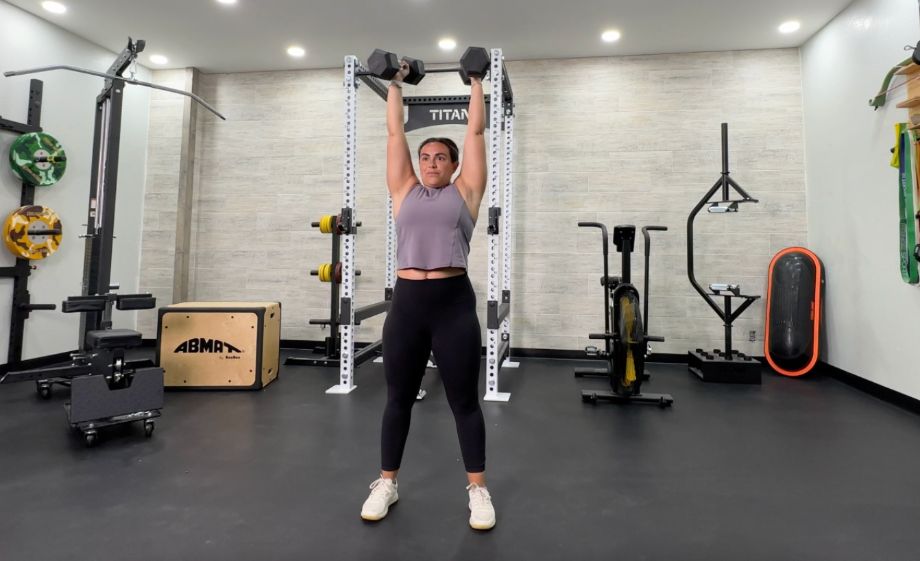
Many of us have seen “that guy” in the gym—the biceps-bulging neighborhood bodybuilding champ just blasting out half reps of the heaviest dumbbells he can find. To the untrained eye, this dude is the real deal, but any personal trainer worth their salt knows half reps don’t count.
“Press the dumbbells overhead through the full range of motion, lock out the elbows, squeeze your delts and traps, then slowly bring the dumbbells back down,” says Amanda. “Half reps are less work, meaning smaller gains, comparatively speaking. Don’t be ‘that guy!’”
Keeping Your Wrists Extended
Your starting position will likely involve an extended wrist, which allows the weights to essentially rest on your palms before you get into your set. That’s fine; this starting wrist positioning should not produce any adverse effects, but you will want to stabilize that wrist as you move so that, in the end position, the positioning is neutral.
“Strong wrists in a neutral positioning minimizes the stress to the wrist joint,” says Amanda. “This can become difficult as you progress to heavier weights. If you’re having a hard time maintaining a neutral wrist, consider using lighter weights, working wrist mobility exercises into your workout routine, or using wrist support when the weights get heavy.”
Dumbbell Shoulder Press Variations
The regular dumbbell shoulder press is as versatile as it is effective. Here are a few variations to keep your routine interesting and keep those gains a-comin’!
Single-Arm Dumbbell Press
Why do it: Using dumbbells rather than a barbell means you have the ability to turn your bilateral shoulder press into a unilateral exercise. That’s especially useful if you’re looking to correct muscle imbalances or address bilateral deficits.
How to do it:
- Stand with your feet shoulder-width apart.
- Hold one dumbbell at shoulder height with your elbows bent and palm facing away. Your non-working hand may rest on your hip to help you maintain a strong posture throughout the range of motion.
- Press the dumbbell overhead until your elbow is fully extended.
- Squeeze the contraction, then slowly return the dumbbell to the starting position, then repeat for reps before switching arms.
“Performing the shoulder press unilaterally helps ensure you’re getting equal muscle activation on each side, since you can focus all your attention and energy on one side at a time,” says Amanda Capritto, CPT, CES, CNC, CF-L1. “Unilateral training does present some balance challenges, however, so be sure to go lighter than you usually do when first trying out the single-arm version.”
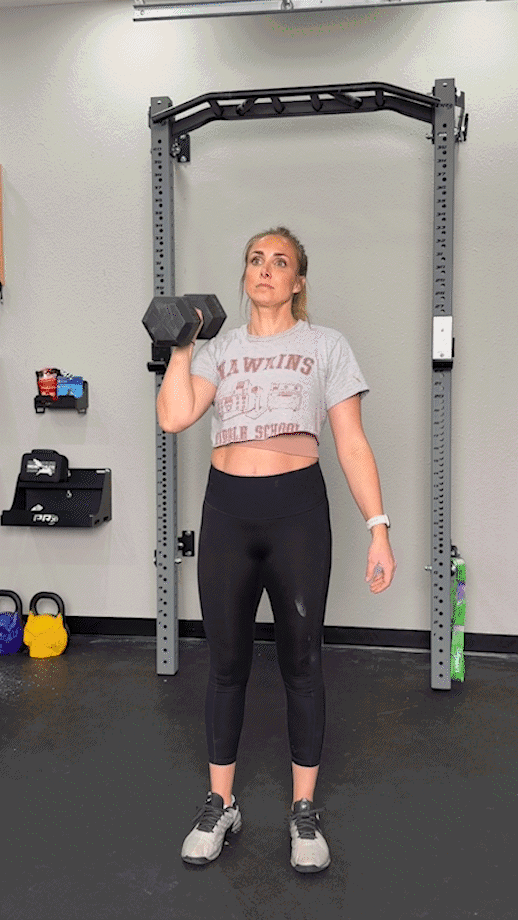
Dumbbell Push Press
Why do it: Alright, we’ve brought up the push press three times now, so we might as well share how you can use this shoulder press variation to move even heavier weight4, which should help you to improve your overall upper body strength, as well as explosive power and cardio capacity.
How to do it:
- Set up your regular dumbbell shoulder press as per usual.
- Push your hips back and bend your knees to dip slightly.
- Extend your hips and knees explosively, using the momentum to thrust the dumbbells upward into the overhead position. Squeeze your glutes and traps in the end position.
- Slowly lower the dumbbells back down, then reset for the next repetition.
RELATED: Explosive Workouts
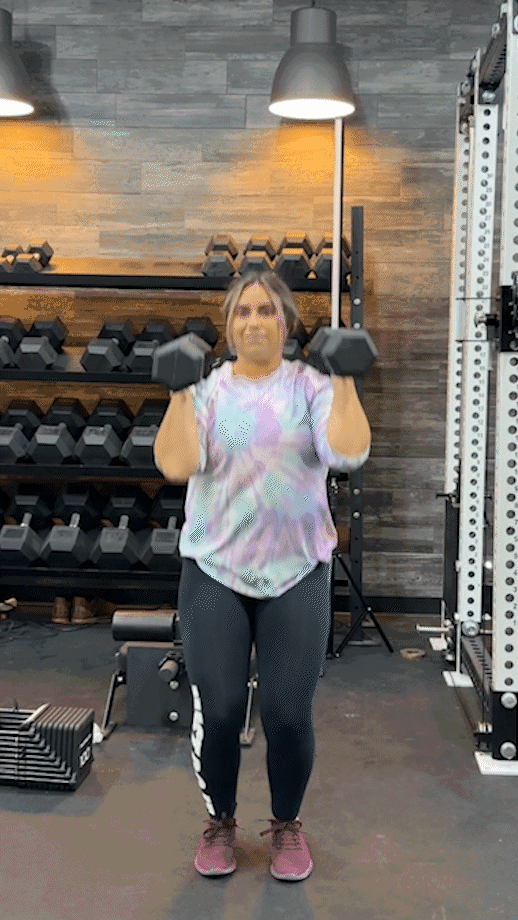
Useful Dumbbell Shoulder Press Equipment and Accessories
The dumbbell shoulder press doesn’t require tons of fancy stuff, so it’s intuitive for lifters to incorporate it in their home gym strength-training sessions. You will need a few bare-bones essentials (e.g. dumbbells), but we also have a few suggestions for accessories and equipment to help make your job easier.
Dumbbells
Using dumbbells for your dumbbell shoulder press is a no-brainer.
Having a set of the best dumbbells can provide more value to your home workouts, even if you’re not an avid weightlifter. From shoulder presses to Arnold presses to lateral raises, dumbbells enable you to do a ton of shoulder exercises, and that’s just the tip of the iceberg.
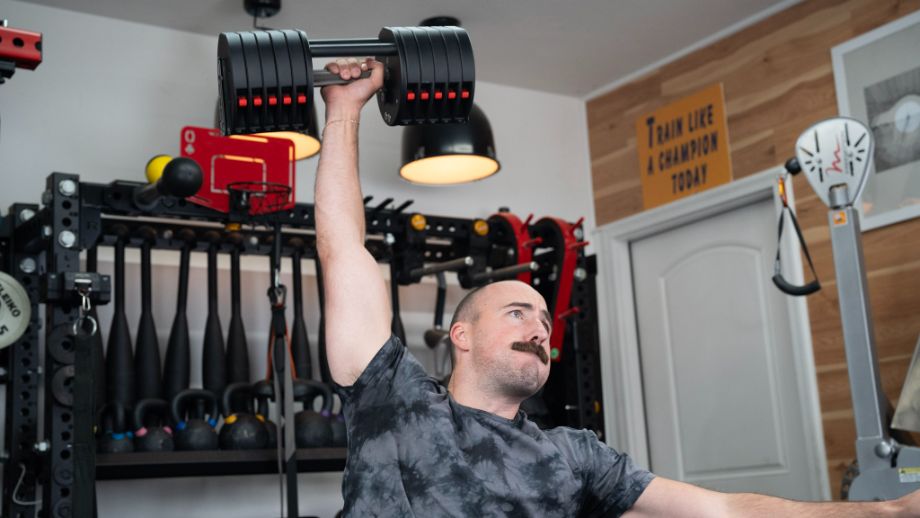
If you’re tight on space or haven’t invested in a dumbbell set because of a lack of storage capacity, we may have a solution for you. Adjustable dumbbells. Some adjustable dumbbells even eliminate the need for several sets and allow you to change your weight by simply turning a dial, making your training session a breeze.
Wrist Wraps
At the top of the press movement, you want to keep your wrists in a strong, neutral position. That becomes increasingly difficult as the weights get heavier and heavier.
Strapping on a pair of the best wrist wraps adds some crucial wrist support to help you eke out those extra reps with excellent form, protecting your wrist from injury and promoting greater gains for your muscle strength, size, and endurance.
Weight Bench
If you have the space available, there’s always a need for a good bench. There are plenty of exercises you can do without a bench, but adding one of the best weight benches unlocks a host of exercises to help take your training to the next level. Think seated dumbbell shoulder presses, incline bench presses, concentration curls for your biceps, and much, much more.
Dumbbell Shoulder Press: FAQs
What does dumbbell press work?
The dumbbell shoulder press primarily works the deltoids, triceps, trapezius, and pectoral muscles, but performing it standing also recruits your core and lower-body muscles, too.
Is a dumbbell press harder than a bench press?
The dumbbell shoulder press involves pressing the weights directly overhead using mostly the arms and shoulders, while the bench press involves lying back on a steady surface and using the arms and chest to push the weight.
Because they work separate muscle groups, they’re not directly comparable. While most people will find one easier than the other, lifters tend to move more weight on the bench press compared to the overhead press.
Is a 70-lb dumbbell press good?
“Moving a 70-pound dumbbell on any lift is considered very good,” says Amanda Capritto, CPT, CES, CNC, CF-L1. “If you’re capable of moving 70-pounds for reps, you may do so, as long as you have good form. On the other hand, if moving a 70-pound dumbbell even once is inordinately difficult, or your form is suffering, use lighter weights and work your way up to 70 pounds as you progress.”
References
1. Niederbracht Y, Shim AL, Sloniger MA, Paternostro-Bayles M, Short TH. Effects of a shoulder injury prevention strength training program on eccentric external rotator muscle strength and glenohumeral joint imbalance in female overhead activity athletes. J Strength Cond Res. 2008;22(1):140-145. doi:10.1519/JSC.0b013e31815f5634
2. Michaud F, Pérez Soto M, Lugrís U, Cuadrado J. Lower Back Injury Prevention and Sensitization of Hip Hinge with Neutral Spine Using Wearable Sensors during Lifting Exercises. Sensors (Basel). 2021;21(16):5487. Published 2021 Aug 14. doi:10.3390/s21165487
3. Farias DA, Willardson JM, Paz GA, Bezerra ES, Miranda H. Maximal Strength Performance and Muscle Activation for the Bench Press and Triceps Extension Exercises Adopting Dumbbell, Barbell, and Machine Modalities Over Multiple Sets. J Strength Cond Res. 2017;31(7):1879-1887. doi:10.1519/JSC.0000000000001651
4. Soriano MA, Suchomel TJ, Comfort P. Weightlifting Overhead Pressing Derivatives: A Review of the Literature. Sports Med. 2019;49(6):867-885. doi:10.1007/s40279-019-01096-8


